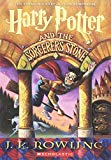
Harry Potter and the Philosopher's Stone tells the tale of Harry, an ordinary boy who discovers he is not so ordinary after all; not only is he a wizard, he is also the target of the evil Lord Voldemort, who tried to kill Harry when he was a baby. As he makes his way through his first year at Hogwarts School of Witchcraft and Wizardry, Harry must again confront Voldemort with the help of his new friends. Major themes include good versus evil and the journey from childhood to adulthood.
Philip Nel highlighted the influence of Jane Austen, whom Rowling has greatly admired since the age of twelve. Both novelists encourage re-reading, because details that look insignificant foreshadow important events or characters much later in the story-line– for example Sirius Black is briefly mentioned near the beginning of Harry Potter and the Philosopher's Stone , and then becomes a major character in the third to fifth books. Like Austen's heroines, Harry often has to re-examine his ideas near the ends of books. Some social behaviour in the Harry Potter books is remininiscent of Austen, for example the excited communal reading of letters. Both authors satirise social behaviour and give characters names that express their personalities.
However in Nel's opinion Rowling's humour is more based on caricature and the names she invents are more like those found in Charles Dickens's stories, and Amanda Cockrell noted that many of these express their owners' traits through allusions that run from ancient Roman mythology to eighteenth-century German literature. Rowling, like the Narnia series' author C.S. Lewis, thinks there is no rigid distinction between stories for children and for adults. Nel also noted that, like many good writers for children, Rowling combines literary genres—fantasy, young-adult fiction, boarding school stories, Bildungsroman and many others.
Some reviewers compared Philosopher's Stone to the stories of Roald Dahl, who died in 1990. Many writers since the 1970s had been hailed as his successor, but none had attained anything near his popularity with children and, in a poll conducted shortly after the launch of Philosopher's Stone , seven of the ten most popular children's books were by Dahl, including the one in top place. The only other really popular children's author of the late 1990s was an American, R. L. Stine. Some of the story elements in Philosopher's Stone resembled parts of Dahl's stories; for example, the hero of James and the Giant Peach lost his parents and had to live with a pair of unpleasant aunts—one fat and one thin rather like Mr. and Mrs. Dursley, who treated Harry as a servant. However Harry Potter was a distinctive creation, able to take on the responsibilities of an adult while remaining a child inside.
Librarian Nancy Knapp and marketing professor Stephen Brown noted the liveliness and detail of descriptions, especially of shop scenes such as Diagon Alley. Tad Brennan commented that Rowling's writing resembles that of Homer: "rapid, plain, and direct in expression." Stephen King admired "the sort of playful details of which only British fantasists seem capable" and concluded that they worked because Rowling enjoys a quick giggle and then moves briskly forward.
Nicholas Tucker described the early Harry Potter books as looking back to Victorian and Edwardian children's stories: Hogwarts was an old-style boarding school in which the teachers addressed pupils formally by their surnames and were most concerned with the reputations of the houses with which they were associated; characters' personalities were plainly shown by their appearances, starting with the Dursleys; evil or malicious characters were to be crushed rather than reformed, including Filch's cat Mrs Norris; and the hero, a mistreated orphan who found his true place in life, was charismatic and good at sports, but considerate and protective towards the weak. Several other commentators have stated that the books present a highly stratified society including many social stereotypes. However Karin Westerman drew parallels with 1990s Britain: a class system that was breaking down but defended by those whose power and status it upheld; the multi-ethnic composition of Hogwarts' students; the racial tensions between the various intelligent species; and school bullying.
Susan Hall wrote that there is no rule of law in the books, as the actions of Ministry of Magic officials are unconstrained by laws, accountability or any kind of legal challenge. This provides an opportunity for Voldemort to offer his own horrific version of order. As a side-effect Harry and Hermione, who were brought up in the highly regulated Muggle world, find solutions by thinking in ways unfamiliar to wizards. For example, Hermione notes that one obstacle to finding the Philosopher's Stone is a test of logic rather than magical power, and that most wizards have no chance of solving it.
Nel suggested that the unflattering characterisation of the extremely conventional, status-conscious, materialistic Dursleys was Rowling's reaction to the family policies of the British government in the early 1990s, which treated the married heterosexual couple as the "preferred norm", while the author was a single mother. Harry's relationships with adult and juvenile wizards are based on affection and loyalty. This is reflected in his happiness whenever he is a temporary member of the Weasley family throughout the series, and in his treatment of first Rubeus Hagrid and later Remus Lupin and Sirius Black as father-figures.
Already have an account? Log In Now